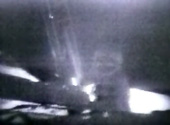The Space Race
The period following the end of World War II was an exciting time in the quest to reach outer space. Jet-propelled planes had been flying since 1939. And German rocket expert Wernher von Braun had successfully launched his V-2 liquid-fuel rockets.
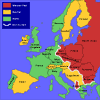 Meanwhile, tension was building between the United States and
the Soviet Union. Each side was concerned and fearful about the
other's intentions in Europe.
Meanwhile, tension was building between the United States and
the Soviet Union. Each side was concerned and fearful about the
other's intentions in Europe.
Since the end of the war, Europe had become divided. The U.S. and its allies controlled western Germany, while the Soviet Union controlled eastern Germany and most of Eastern Europe.
The Cold War had begun. A fierce competition grew between the two sides. Each wanted to show that its system of government, its economy, and its way of life were superior.
The two sides would compete on many levels, including efforts to reach outer space.
Von Braun Comes to the U.S.
At the end of World War II, Wernher von Braun and his team of German rocket scientists surrendered to the Americans. The United States jealously protected von Braun and his team from Soviet agents.
A team of American scientists travelled to Europe in 1945. They collected information and equipment related to German rocketry. They collected V-2 rocket parts and assembled them. And they searched for German rocket technicians.
 By the end of 1945, more than 100 German scientists arrived at Fort Bliss.
Fort Bliss is a U.S. Army post near El Paso, Texas.
By the end of 1945, more than 100 German scientists arrived at Fort Bliss.
Fort Bliss is a U.S. Army post near El Paso, Texas.
Piled up in the desert near Las Cruces, New Mexico, were enough parts to build 100 V-2s. Von Braun and his team soon moved to the nearby White Sands Proving Ground, an Army missile-testing range. At White Sands, the team assembled and launched V-2s.
 By February 1946, von Braun's entire Peenemunde team was reunited at
White Sands. On April 16, the first V-2 to be launched in the U.S.
lifted off. The U.S. space program was underway.
By February 1946, von Braun's entire Peenemunde team was reunited at
White Sands. On April 16, the first V-2 to be launched in the U.S.
lifted off. The U.S. space program was underway.
The Army's missile program later moved from White Sands to Redstone Arsenal in Alabama. Redstone Arsenal is an Army rocket research and development centre near the city of Huntsville. Von Braun and his team arrived in April 1950. Huntsville would be his home for the next 20 years.
 At Redstone Arsenal, von Braun worked to develop a kind of "super
V-2" rocket. In honour of the place it was built, the rocket was
called the Redstone. The Redstone was designed to launch
warheads at targets about
370 kilometres (200 nautical miles) away.
At Redstone Arsenal, von Braun worked to develop a kind of "super
V-2" rocket. In honour of the place it was built, the rocket was
called the Redstone. The Redstone was designed to launch
warheads at targets about
370 kilometres (200 nautical miles) away.
 In 1956, the Army Ballistic Missile Agency (ABMA) was created at
Redstone Arsenal. Von Braun was in charge of the agency. His main
goal was to develop the Jupiter rocket.
In 1956, the Army Ballistic Missile Agency (ABMA) was created at
Redstone Arsenal. Von Braun was in charge of the agency. His main
goal was to develop the Jupiter rocket.
The Jupiter was a longer version of the Redstone. It used a different kind of fuel and could fly greater distances.
Sputnik
 On October 4, 1957, the Soviet Union launched Sputnik 1. In Russian,
Sputnik means travelling companion, and it was the first artificial
satellite to
orbit Earth.
On October 4, 1957, the Soviet Union launched Sputnik 1. In Russian,
Sputnik means travelling companion, and it was the first artificial
satellite to
orbit Earth.
Sputnik weighed only 83.5 kilograms (184 pounds). It sent out radio signals as it circled the planet. Sputnik also measured temperatures in Earth's upper atmosphere.
| Listen to the radio signals from Sputnik as it passed overhead. NASA audio. |
Sputnik grabbed the whole world's attention and caught the U.S. off guard. Many in the U.S. feared that if the Soviets could launch a satellite, they might also be able to launch nuclear weapons.
 The Sputnik launch marked the beginning of the space race between the
United States and the Soviet Union. This race would continue for many
years as each country strived to be the "first" in each major space event.
The Sputnik launch marked the beginning of the space race between the
United States and the Soviet Union. This race would continue for many
years as each country strived to be the "first" in each major space event.
 Less than a month after the launch of Sputnik 1, the Soviets scored another
first. On November 3, 1957, a dog named Laika became the first living creature
ever sent into space.
Less than a month after the launch of Sputnik 1, the Soviets scored another
first. On November 3, 1957, a dog named Laika became the first living creature
ever sent into space.
Laika (nicknamed "Mutnik" by the media) rode into orbit aboard Sputnik 2. She survived for a few days until the cabin overheated.
In the early 20th century, air races encouraged advances in airplane design. In a similar way, the space race helped bring about rapid improvements in space technology.
In just under 12 years, the world went from launching the first satellite to landing humans on the moon.
Explorer 1
 Following the launch of Sputnik 1, the U.S. scrambled to catch up to the
Soviet Union. On January 31, 1958, the U.S. launched its first artificial
satellite.
Following the launch of Sputnik 1, the U.S. scrambled to catch up to the
Soviet Union. On January 31, 1958, the U.S. launched its first artificial
satellite.
Explorer 1 weighed about 14 kilograms (30.7 pounds). It contained instruments to detect cosmic rays, record temperatures, and detect micrometeorites.
 Explorer 1's whip-like outer antennas sent radio signals back to Earth.
Explorer 1's whip-like outer antennas sent radio signals back to Earth.
| Explorer's audio signal. Audio file courtesy Roy D. Welch, W0SL. |
 Drs. Wernher von Braun, William Pickering, and James Van Allen designed
and built Explorer 1. The satellite was launched with a Jupiter-C rocket,
a modified version of the Redstone rocket.
Drs. Wernher von Braun, William Pickering, and James Van Allen designed
and built Explorer 1. The satellite was launched with a Jupiter-C rocket,
a modified version of the Redstone rocket.
As it orbited Earth, Explorer 1 detected a belt of charged particles trapped in space by Earth's magnetic field. The particles produced belts of high-intensity radiation. These belts were later named the Van Allen radiation belts after James Van Allen.
The Birth of NASA
 Another consequence of the launch of Sputnik 1 was the birth of NASA,
the National Aeronautics and Space Administration.
Another consequence of the launch of Sputnik 1 was the birth of NASA,
the National Aeronautics and Space Administration.
Soon after Sputnik, the U.S. Congress held a number of special hearings. The purpose of the hearings was to find out how to unify and speed up America's space efforts.
Until that time, several agencies had been involved in different aspects of space research. Sometimes these agencies squabbled over who owned what "turf" when it came to rockets.
 Congress recommended that a civilian
agency should be set up to carry out the non-military exploration of space.
President Dwight D. Eisenhower agreed, and on July 29, 1958, a law was passed to
create NASA.
Congress recommended that a civilian
agency should be set up to carry out the non-military exploration of space.
President Dwight D. Eisenhower agreed, and on July 29, 1958, a law was passed to
create NASA.
NASA replaced the National Advisory Council for Aeronautics (NACA). The NACA was formed in 1915 to advise the government on developments in aircraft technology.
NASA absorbed parts of other agencies such as the Army Ballistic Missile Agency and the Naval Research Laboratory.
Unpiloted Missions
 When you think of space exploration, what's the first thing that comes to your mind? Many people think of piloted missions: for example, the Apollo moon landings, the space shuttle, and the International Space Station.
When you think of space exploration, what's the first thing that comes to your mind? Many people think of piloted missions: for example, the Apollo moon landings, the space shuttle, and the International Space Station.
Piloted missions may be more "glamorous" and receive more media attention than unpiloted missions.
But unpiloted missions are responsible for most of what we know about outer space. Unpiloted missions are much cheaper to carry out than human missions, and they pose no risk to human life.
 In general, unpiloted missions can be split into two categories: artificial
satellites and space probes.
In general, unpiloted missions can be split into two categories: artificial
satellites and space probes.
Artificial satellites (such as Sputnik) orbit Earth. Probes (such as Galileo) travel great distances through outer space before striking, orbiting, or landing softly on celestial bodies.
Most of the satellites and probes launched have studied Earth and the moon.
Moon Probes
 Following the Sputnik and Explorer launches, the Soviet Union and the United
States turned their attention to the moon.
Following the Sputnik and Explorer launches, the Soviet Union and the United
States turned their attention to the moon.
About 50 unpiloted moon missions were launched in the 10 years after Sputnik. These missions went from the simple to the complex: from flying past the moon, to striking it, to landing softly on it.
The first challenge was to develop the technology to take a probe to the moon.
Within nine months of Explorer 1, the U.S. launched the first unpiloted
lunar probe. But its rocket failed 45
seconds after liftoff.
 The Soviet Union was more successful with Luna 1. This probe flew past the moon in January of 1959. In the fall of that year, Luna 2 struck the surface of the moon.
The Soviet Union was more successful with Luna 1. This probe flew past the moon in January of 1959. In the fall of that year, Luna 2 struck the surface of the moon.
 A few weeks after that, Luna 3 took the first pictures of the far side of the moon.
A few weeks after that, Luna 3 took the first pictures of the far side of the moon.
View more images of the far side of the Moon.
 Between 1959 and 1976, 24 Luna missions would orbit, land on, explore, and
photograph the moon.
Between 1959 and 1976, 24 Luna missions would orbit, land on, explore, and
photograph the moon.
Luna 16 brought samples of the moon's surface back to Earth in
1970. But by then, the U.S. Apollo program had already landed men on the moon.
Learn more about the Luna missions.
 Between 1958 and 1960, the U.S. attempted a series of unpiloted missions to the
moon. The early Pioneer probes were designed to photograph and obtain scientific
data about the moon.
Between 1958 and 1960, the U.S. attempted a series of unpiloted missions to the
moon. The early Pioneer probes were designed to photograph and obtain scientific
data about the moon.
In general, these probes were unsuccessful because of launch failures. Only one of eight probes--Pioneer 4--accomplished its intended mission to the moon.
Several Pioneer probes were stranded in orbits between Earth and the moon. These probes did provide important information on the number and extent of the radiation belts around Earth.
But at the beginning of the 1960s,
the U.S. lagged well behind the Soviet Union in the space race.
Learn more about the Pioneer probes.
The Ranger missions (1961-1965) were the first U.S. attempts to take close-up photographs of the moon. In 1964 and 1965, Ranger probes took thousands of black-and-white photographs of the moon as they descended and crashed into the lunar surface.

|

|
The Ranger series supplied very detailed data. But mission planners for the coming Apollo piloted moon missions needed more extensive data. The final two unpiloted lunar programs were designed to work together.
The U.S. Lunar Orbiter missions (1966-1967) provided an extensive map of the lunar surface.
The Surveyor missions (1966-1968) landed softly on the moon and provided detailed colour photographs of the surface. Surveyor also collected other data about the moon's surface.

|

|
This information convinced scientists that the moon's surface was solid enough to support the weight of piloted spacecraft. Planners were then able to identify sites for the piloted landings.
Interplanetary Probes
Most human efforts in space have focussed on Earth and the moon. But driven by the space race, the United States and Soviet Union soon began to explore the rest of the solar system. This section will give you a look at the highlights and "firsts" of solar system exploration.
Venus and Mars--the two planets closest to Earth--were the first planets to be explored. In 1962, the U.S. Mariner 2 probe was the first to fly past Venus. And in 1965, Mariner 4 took the first close-up photographs of the surface of Mars.

|

|
 Venus was the target of the Soviet Union's Venera program. In 1966, Venera 3 was
the first probe to strike another planet.
Venus was the target of the Soviet Union's Venera program. In 1966, Venera 3 was
the first probe to strike another planet.
The Soviets followed this achievement
with Venera 4. In 1967, this probe was the first to enter Venus's atmosphere and
study its composition.
In 1970, Venera 7 became the first probe to land on another planet.
Learn more about the Venera program.
In July 1969, the U.S. won the final leg of the space race when astronaut Neil Armstrong set foot on the moon. But both the U.S. and Soviet Union continued sending unpiloted missions into space.
 The Soviet Union scored major firsts on Mars in 1971. The Mars 2 probe
struck the surface of the planet. Mars 3 landed softly and sent back 20
seconds of blurry video images.
The Soviet Union scored major firsts on Mars in 1971. The Mars 2 probe
struck the surface of the planet. Mars 3 landed softly and sent back 20
seconds of blurry video images.
Also in 1971, the U.S. Mariner 9 probe became the first to orbit another planet (Mars).
In late 1972, the U.S. Pioneer 10 probe became the first to travel through the asteroid belt between Mars and Jupiter.
In 1973, Pioneer 10 was the first to reach and send home images of Jupiter. In 1983, this elderly probe became the first to leave the solar system.

|

|
 Mercury became the focus of attention in 1974. That's when Mariner 10 became the first to reach and photograph the planet closest to the sun.
Mercury became the focus of attention in 1974. That's when Mariner 10 became the first to reach and photograph the planet closest to the sun.
Learn more about Mariner 10.
 The world had its first close-up look at Venus in 1975. That's when the Soviet Union's Venera 9 sent home the first images of the planet's surface.
The world had its first close-up look at Venus in 1975. That's when the Soviet Union's Venera 9 sent home the first images of the planet's surface.
Mars was back in the spotlight in 1975. In that year, the two U.S. Viking probes landed and searched for signs of life on the planet. They found none, but they discovered ice.
The Viking missions also monitored the planet's weather, and mapped and photographed its surface.

|

|

|

|
In 1978, Pioneers 12 and 13 mapped the surface of Venus and sent probes into its lower atmosphere.
And in 1979, Pioneer 11 took the first close-up images of Saturn and its rings during its flyby of the planet.

|

|
Learn more about Pioneer 11.
The two U.S. Voyager probes sent home huge amounts of valuable information about the outer planets. Launched in the late 1970s, the Voyagers gave us the first close-up images of Uranus (1986) and Neptune (1989).

|

|
Among many discoveries, we learned that Jupiter's Great Red Spot is a giant storm. We found out that Saturn's rings are made up of particles of ice and rock. And the Voyagers discovered a total of 22 new moons around these planets.
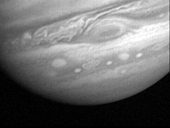 Jupiter's Great Red Spot as seen by Voyager 1. This animation was created from a series of still photographs. NASA image.
Jupiter's Great Red Spot as seen by Voyager 1. This animation was created from a series of still photographs. NASA image.
|
In 1986, several probes gave us a closer look at Halley's comet. The two Soviet Vega
probes, the Japanese probes Sakigake and Suisei, and the European
Giotto probe all took photographs of the potato-shaped nucleus of the comet.
Learn more about the Vega probes, Sakigake and Suisei, and Giotto.

|

|
The U.S. returned to Venus with the Magellan probe. Magellan orbited the planet and mapped its surface from 1990 to 1994.

|

|
 The U.S. teamed up with Europe to send a probe called
Galileo to Jupiter in 1989. Galileo took the first close-up pictures of an asteroid (Gaspra).
The U.S. teamed up with Europe to send a probe called
Galileo to Jupiter in 1989. Galileo took the first close-up pictures of an asteroid (Gaspra).
Learn more about the Galileo probe.
In 1995, Galileo explored Jupiter's hostile atmosphere. It also took close-up pictures of Jupiter's moons Io, Ganymede, Europa, and Callisto.

|

|
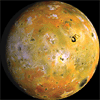
|
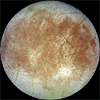
|
 In the early 1990s, two probes took aim at the sun.
In the early 1990s, two probes took aim at the sun.
A U.S.-European probe called Ulysses orbited high above the sun's poles. Ulysses studied the sun's magnetic field, solar wind plasma, and galactic cosmic rays.
Another probe called Yohkoh
studies solar flares
and other events on the sun. Yohkoh was a team effort by Japan, the U.S., and Britain.
Learn more about the
Ulysses
and Yohkoh probes.
 The U.S. Near Earth Asteroid Rendezvous (NEAR) Shoemaker probe was launched in 1996.
Its mission was to study an asteroid
called Eros.
The U.S. Near Earth Asteroid Rendezvous (NEAR) Shoemaker probe was launched in 1996.
Its mission was to study an asteroid
called Eros.
NEAR was the first to orbit an asteroid. And in 2001, it was the first to
land on an asteroid.
Learn more about NEAR.
Mars was back on the exploration map in the late 1990s. In 1997, Mars Pathfinder delivered a lander and a rover (called Sojourner) to the surface of the planet.
Learn more about Mars Pathfinder.

|
 Another probe called Mars Global Surveyor began a mapping mission in 1999. It found evidence that there may be liquid water on the planet.
Another probe called Mars Global Surveyor began a mapping mission in 1999. It found evidence that there may be liquid water on the planet.
Learn more about Mars Global Surveyor.
 The 2001 Mars Odyssey will further map the surface and search for water. Odyssey will also assess the danger of
radiation for future human visitors.
The 2001 Mars Odyssey will further map the surface and search for water. Odyssey will also assess the danger of
radiation for future human visitors.
Learn more about the 2001 Mars Odyssey.
 The U.S. Deep Space 1 probe flew past a near-Earth asteroid (called Braille) in 1999. The probe also took the best-ever images of a comet (called Borrelly) in 2001.
The U.S. Deep Space 1 probe flew past a near-Earth asteroid (called Braille) in 1999. The probe also took the best-ever images of a comet (called Borrelly) in 2001.
Learn more about Deep Space 1 probe.
 In 1997, the U.S. and Europe launched a two-probe mission called Cassini and Huygens. As this feature was being produced, Cassini-Huygens was on its way to study Saturn and Titan, one of its moons. The probes are scheduled to arrive at Saturn in July 2004.
In 1997, the U.S. and Europe launched a two-probe mission called Cassini and Huygens. As this feature was being produced, Cassini-Huygens was on its way to study Saturn and Titan, one of its moons. The probes are scheduled to arrive at Saturn in July 2004.
Learn more about Cassini and Huygens.
Explore the table of Unpiloted Space Exploration for a more in-depth look at the history and future of unpiloted space missions. Upcoming unpiloted missions are also discussed in a section of this feature called The Future.
Piloted Missions
Yuri Gagarin -- First Human in Space
 The Soviet Union took the lead in putting people into space. On April 12, 1961, a Vostok
spacecraft took cosmonaut Yuri Gagarin
into orbit.
The Soviet Union took the lead in putting people into space. On April 12, 1961, a Vostok
spacecraft took cosmonaut Yuri Gagarin
into orbit.
Gagarin was both the first human in space and the first to orbit Earth. After
one complete orbit in 108 minutes, he returned safely to Earth.
 Launch of Yuri Gagarin, the first human in space. NASA video.
Launch of Yuri Gagarin, the first human in space. NASA video.
|
Learn more about Yuri Gagarin.
The Mercury Program
In October 1958, the United States approved the Mercury program. The goal of Mercury was to send a human into space aboard a one-person spacecraft.
 Although the Soviet Union achieved this goal first,
the U.S. wasn't far behind. On May 5, 1961, a Mercury Redstone
rocket lifted off with astronaut Alan Shepard aboard.
Although the Soviet Union achieved this goal first,
the U.S. wasn't far behind. On May 5, 1961, a Mercury Redstone
rocket lifted off with astronaut Alan Shepard aboard.
Shepard did not reach orbit around Earth. But he did achieve suborbital flight for 15 minutes and 22 seconds.
That made Shepard the first American in space. About two months later, another Mercury Redstone sent astronaut Virgil "Gus" Grissom into another suborbital flight.
 The U.S. space program answered the Soviet challenge with Project Mercury. This clip shows Mercury's seven astronauts and Alan Shepard's suborbital flight on May 5, 1961. NASA video.
The U.S. space program answered the Soviet challenge with Project Mercury. This clip shows Mercury's seven astronauts and Alan Shepard's suborbital flight on May 5, 1961. NASA video.
|
 On February 20, 1962, a Mercury Atlas rocket launched astronaut
John Glenn into space. Glenn was the first American to achieve orbit.
He circled Earth three times.
On February 20, 1962, a Mercury Atlas rocket launched astronaut
John Glenn into space. Glenn was the first American to achieve orbit.
He circled Earth three times.
The six flights of the Mercury program proved that the U.S. could
safely send an astronaut into orbit. Mercury was an important first
step toward an even more daring mission to come.
Learn more about the Mercury program.
Kennedy's Call to the Moon
On May 25, 1961, U.S. President John F. Kennedy gave a historic speech. He spoke to a joint session of the U.S. Congress.
About six weeks earlier, Soviet cosmonaut Yuri Gargarin had become the first human in space. U.S. leaders felt embarrassed at being defeated in that part of the space race.
During his speech, Kennedy announced a dramatic goal. He wanted the country to send an American to the moon by the end of the 1960s.
Here is part of what Kennedy had to say:
 Portion of President Kennedy's moon speech. NASA video.
Portion of President Kennedy's moon speech. NASA video.
|
|
...I believe that this nation should commit itself to achieving the goal, before this decade is out, of landing a man on the moon and returning him safely to the earth. No single space project in this period will be more impressive to mankind, or more important for the long-range exploration of space; and none will be so difficult or expensive to accomplish. We propose to accelerate the development of the appropriate lunar space craft. We propose to develop alternate liquid and solid fuel boosters, much larger than any now being developed, until certain which is superior. We propose additional funds for other engine development and for unmanned explorations--explorations which are particularly important for one purpose which this nation will never overlook: the survival of the man who first makes this daring flight. But in a very real sense, it will not be one man going to the moon--if we make this judgment affirmatively, it will be an entire nation. For all of us must work to put him there. |
Kennedy's speech surprised many people in government and even in NASA. They wondered whether such an ambitious goal could be achieved at all.
But the U.S. Congress approved Kennedy's request for more money for the space program. Projects Mercury, Gemini, and Apollo were designed to achieve Kennedy's goal.
The speed of the space race increased.
More Soviet "Firsts"
 On June 16, 1963, cosmonaut Valentina Tereshkova became the first
woman to reach outer space. The Soviet Union launched Tereshkova
aboard a Vostok 6 capsule.
On June 16, 1963, cosmonaut Valentina Tereshkova became the first
woman to reach outer space. The Soviet Union launched Tereshkova
aboard a Vostok 6 capsule.
The Soviets followed up this achievement with the first spacewalk (or extravehicular activity, EVA). Cosmonaut Alexei Leonov spent 20 minutes floating in space on March 18, 1965. Leonov was attached to his Voskhod 2 capsule by a 3-metre (10-foot) tether.
 Alexei Leonov's spacewalk in March 1965. NASA video.
Alexei Leonov's spacewalk in March 1965. NASA video.
|
The Gemini Program
The United States announced the Gemini program on December 7, 1961. The major goal of Gemini was to send a two-person spacecraft into orbit.

|

|

|
 On one of the 10 Gemini flights, astronaut Edward White became the first
American to perform a spacewalk or EVA. On June 3, 1965, White spent 23
minutes outside the Gemini 4 capsule.
On one of the 10 Gemini flights, astronaut Edward White became the first
American to perform a spacewalk or EVA. On June 3, 1965, White spent 23
minutes outside the Gemini 4 capsule.
He moved around in space using a small, hand-held gas gun. When the gas ran out, he pulled himself around on an 8-metre (26-foot) tether that attached him to the capsule.
 Astronaut Edward White becomes the first American to perform a spacewalk. NASA video.
Astronaut Edward White becomes the first American to perform a spacewalk. NASA video.
|
 Gemini helped develop the technology, skills, and knowledge needed for
a moon mission.
Gemini helped develop the technology, skills, and knowledge needed for
a moon mission.
Learn more about the Gemini program.
The Apollo Program
President John F. Kennedy and rocket expert Dr. Wernher von Braun dreamed of putting humans on the moon. The Apollo program was the final step in turning their dreams into reality.
Apollo's main goal was to land astronauts on the moon and return them safely to Earth. Apollo also aimed to:
- create the technology needed for American interests in space
- achieve superiority in space for the U.S.
- carry out scientific exploration of the moon, and
- develop the ability for humans to work on the moon
 To reach the moon, the Apollo program would need the most powerful
rockets ever built. Von Braun and his team would develop the
mighty Saturn rockets to do the job. The program would use a
three-person spacecraft.
To reach the moon, the Apollo program would need the most powerful
rockets ever built. Von Braun and his team would develop the
mighty Saturn rockets to do the job. The program would use a
three-person spacecraft.
The program's first mission ended in tragedy. On January 27, 1967, an electrical fire broke out inside the Apollo 1 capsule during a countdown rehearsal. The fire burned quickly and fiercely because of the pure oxygen in the capsule.
The capsule's hatch was difficult to open, and the crew could not escape in time. Virgil "Gus" Grissom, Edward H. White, and Roger B. Chaffee were the first American astronauts to die in a spacecraft.

|

|
For a while after the deaths, the speed of the Apollo program slowed. NASA worked to fireproof the Apollo capsule and install a hatch that opened quickly. A safer mix of oxygen and nitrogen would be used in the capsule during future launches.
 The program took to the sky again in October 1968 with Apollo 7. The
crew spent almost 11 days in Earth orbit. That was more time in space
than all the previous Soviet missions combined.
The program took to the sky again in October 1968 with Apollo 7. The
crew spent almost 11 days in Earth orbit. That was more time in space
than all the previous Soviet missions combined.
 In December 1968, Apollo 8 became the first mission to orbit the moon.
The astronauts took pictures of possible landing sites. They also shot
the first live television footage of the moon's surface.
In December 1968, Apollo 8 became the first mission to orbit the moon.
The astronauts took pictures of possible landing sites. They also shot
the first live television footage of the moon's surface.
In March 1969, Apollo 9 was the first mission to test the lunar lander while in Earth orbit.

|

|
 And two months later, Apollo 10 tested the lander while in orbit around
the moon. The lander came within 16 kilometres (10 miles) of the moon's
surface.
And two months later, Apollo 10 tested the lander while in orbit around
the moon. The lander came within 16 kilometres (10 miles) of the moon's
surface.
Finally, the U.S. was ready to attempt a moon landing. On July 16, 1969, Apollo 11 blasted off from Kennedy Space Center in Florida. On board were astronauts Neil Armstrong, Michael Collins, and Edwin "Buzz" Aldrin.

|

|
 A close-up view of the Apollo 11 launch at the Kennedy Space Center, Florida, on July 16, 1969. NASA video.
A close-up view of the Apollo 11 launch at the Kennedy Space Center, Florida, on July 16, 1969. NASA video.
|
 The Apollo 11 launch from a distance. NASA video.
The Apollo 11 launch from a distance. NASA video.
|
 Four days later, people were glued to their televisions as Apollo 11's
lunar module settled onto the surface
of the moon. A voice crackled: "Houston, the Eagle has landed." Six hours
later, astronaut Neil Armstrong became the first human to set foot on the moon.
Four days later, people were glued to their televisions as Apollo 11's
lunar module settled onto the surface
of the moon. A voice crackled: "Houston, the Eagle has landed." Six hours
later, astronaut Neil Armstrong became the first human to set foot on the moon.
 Eight years after his famous moon speech, President Kennedy's dream had come true. Humans had walked on
the moon. In a few days, they would return safely to Earth.
Eight years after his famous moon speech, President Kennedy's dream had come true. Humans had walked on
the moon. In a few days, they would return safely to Earth.
 Five more Apollo missions were sent to the moon. Four of them successfully
landed astronauts on the moon.
Five more Apollo missions were sent to the moon. Four of them successfully
landed astronauts on the moon.
In 1970, the Apollo 13 mission was aborted after an explosion in one of the oxygen tanks. The crew orbited the moon, but had to return to Earth without setting foot on the lunar surface.
On December 14, 1972, Apollo 17 astronaut Eugene Cernan became the last human to walk on the moon.
 An Apollo 16 astronaut drives a rover on the moon. NASA video.
An Apollo 16 astronaut drives a rover on the moon. NASA video.
|
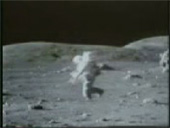 Astronaut Eugene Cernan walks on the moon. NASA video.
Astronaut Eugene Cernan walks on the moon. NASA video.
|
The moon landings were important for a number of reasons.
They were the greatest technological triumphs in history. For the first time, humans had set foot on another celestial body. And scientists learned a great deal about the composition and history of the moon.
The Soviet Union had sent many unpiloted Luna probes to the moon. But the Soviets were not able to keep up to the Americans in piloted missions.
When Neil Armstrong stepped onto the lunar surface, the U.S. won the race to the moon.
The space race was over.
Learn more about the Apollo program.
